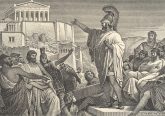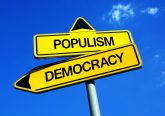The Five Star Movement is one of the most interesting political ‘experiments’ on political landscape of Western democracies. Once again Italy, which with Berlusconi has experienced Trumpism before Donald Trump, is a political laboratory for novel political phenomena that the world looks at, with a mixture of concern and excitement, to learn something about the future of our democratic systems.
Only five years ago Beppe Grillo, a stand-up comedian and the founder of the Five Star Movement (M5S), launched his parole guerriere (warlike words) and M5S obtained a remarkable 25% of the national vote in its first electoral showing.
Italian voters again expressed loudly and clearly their preference for the Five Star Movement in last weekend’s general election. The M5S not only received more than 30% of the national vote, but also became the party most voted for in Southern Italy since 1948.
The Birth of the Five Star Movement and its Electoral Coming-of-Age
The story of the Five Star Movement’s ‘soul’ and the deep-seated frustrations it has capitalized on can be traced back to the beginning of the 90s. Beppe Grillo, after being ousted from Italian public television, started a series of performances and public demonstrations against the corruption of the Italian political system, known as Tangentopoli (Bribesville). The incredible success of Grillo’s political satire in the early 2000s led to the opening of his highly influential personal blog beppegrillo.it and the launch of a series of initiatives to address the failures of Italia’s party system and establishment politics.
Thanks to the massive popularity of and participation in Beppe Grillo’s initiatives, both in the virtual realm – his blog became one of the most visited blog worldwide, and on the streets – in the mass manifestations called V-day (V stands for Vaffanculo, a common expression translatable as ‘Fuck-off’) – a precursor of today’s Five Star Movement developed. The Amici di Beppe Grillo (Beppe Grillo’s friends) participated in several local elections from 2007 to 2009, relying on grassroots’ activisms and social networks to coordinate their efforts.
Based on these first experiences with politics, Beppe Grillo – after the Italian Democratic Party refused his candidacy to the party’s primary election in 2009 – announced on October 4th, 2009 the birth of the Five Star Movement.
The first important political test was the 2013 national election, where the M5S – against all the election polls’ predictions – succeeded in becoming the second-largest party with 163 members elected to Parliament.
While not coming completely out of the blue, the remarkable success of the M5S during the first time that the newly-formed political party competes in national elections is unique in Western democracies. Other anti-establishment forces such as the AfD in Germany, Syriza in Greece or Podemos in Spain, did not perform that well immediately.
In 2016, local elections brought another remarkable electoral success of the Five Star Movement as 38 of its candidates were elected mayors, some of them in important cities such as Turin and Rome.
Along with its increasing political importance, the M5S has attracted considerable criticism for refusing alliances with the traditional political parties and for the command and control centralised management of its parliamentary group. These political choices can be explained not only by its willingness to preserve its founding principles, but also, more practically, to maintain its underlying electoral consensus.
M5S: Populist or a Different Beast?
The M5S has repeatedly drawn a clear line between itself and established political parties. For instance, in September 2017, Luigi Di Maio won an online primary election to become the new political head of the Movement and prime ministerial candidate. This first in “live broadcasting representative democracy”[1] has massively changed the Italian political scenario, by introducing new forms of internet-based political participation.
M5S approach to politics is not just innovative in terms of political participation,[2] but also from an ideological stand point. It combines horizontal communication between and among citizens with a diffuse anti-establishment disgust, environmentalist and anti-globalist sentiments, the professed willingness to protect and promote the common goods.
This ‘ecumenical’ character distinguishes M5S from other cases of anti-establishment movements. The majority of anti-establishment parties, such as the Spanish Podemos, the Greek Syriza, or the French Front National are rooted in traditional political ideologies. The Five Star Movement, on the other hand, is hardly classifiable under traditional political labels. Its post-ideological political ideology creates an interesting ‘melting-pot’ that cannot be easily or fully subsumed under the catch-all term of populism.
Populism is, of course, the political buzzword of the day, since at least the financial crisis of 2008. It has been used not only to identify a wide range of anti-established and anti-neoliberalism movements, but also as an evergreen ‘offensive tool’ of labelling every type of political opponent. As always happens with catch-all definitions that are stretched too far, they are in danger of becoming too broad to convey much meaning at all. Arguably, if the core of populism is a strong appeal to the idea of the people, a certain degree of populism is intrinsic to democratic politics.
In my estimation, the definition that fits the Five Star Movement better is one of a social movement. As advanced by Class Offe, social movements as those political bodies that “develop a meta-political critique of the social order and of representative democracy, challenging institutional assumptions regarding conventional ways of doing politics, in the name of radical democracy.”[3]
From Winning Votes to Governing?
Using innovative strategies of participation and ideological flexibility have served the M5S well, as it has been able to attract voters from all corners of the political spectrum. An analysis of voter flows from 2013 national election shows M5S capacity “of attracting similar amounts of former Partito Democratico and Popolo della Libertà supporters, as well as a considerable amount of voters from their traditional allies: Lega Nord and Italia dei Valori”.[4]
The M5S remarkable rise from Beppe Grillo’s political satire to effective electoral vehicle for channelling disenchantment with establishment politics and rejection of the status quo has culminated in a remarkable victory in last weekend’s election. Gaining 32.2% of votes and increasing its vote shares by over 6%, the Five Star Movement is Italy’s strongest individual political party. With no clear majorities for either coalition and losses of the traditional parties, Italy’s election have produced, as expected, a hung parliament. This opens the door to an unprecedented scenario: a M5S government is not unthinkable anymore.
[1] See Nadia Urbinati (2013) Mobilisations en réseaux, activis menu mérique : les nouvelles attentes participatives, Esprit, 87-97.
[2]Eric Turner (2012) The Grillini in Italy: New Horizons for Internet-based Mobilization and Participation, Social Movement Studies, 12:2, 214-220.
[3] Claus Offe (1985) New Social Movements, Social Research 52, 817-68. See also, Donatella della Porta and Manuela Caiani (2009) Social Movements and Europeanization, Oxford University Press.
[4]Russo Luana, Pedro Riera and Tom Verthé (2017) Tracing the electorate of the Movimento Cinque Stelle: An ecological inference analysis, Italian Political Science Review/Rivista Italiana Di Scienza Politica, 47(1), 45-62







